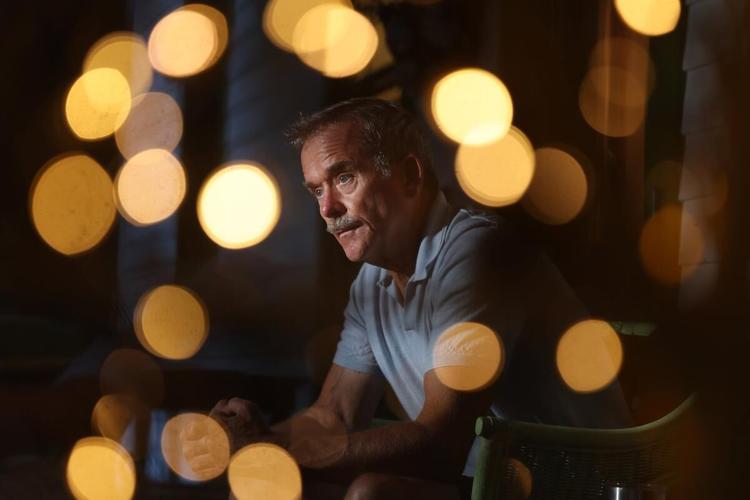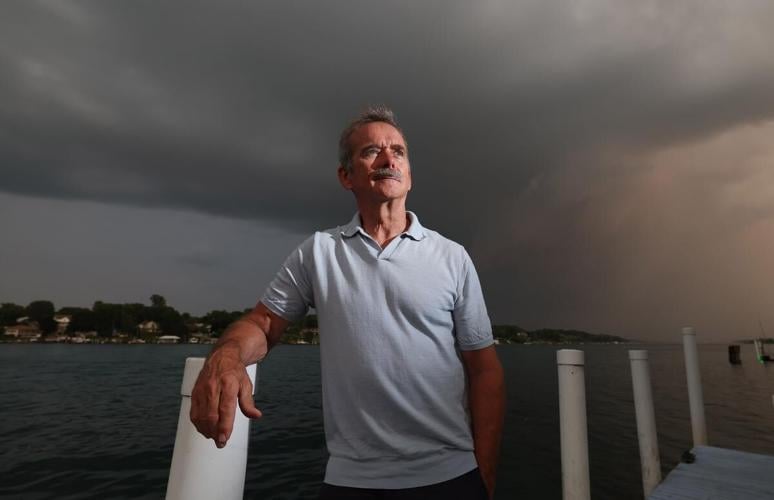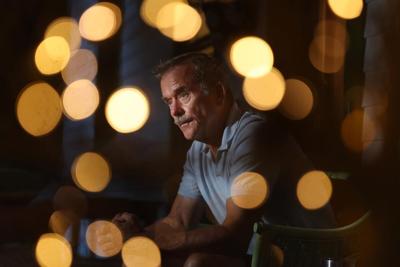The grey sky has made the river that Chris Hadfield’s motorboat is speeding across the colour of dark steel. We had driven out to Sarnia, the photographer and me, past fields of giant windmills, keeping pace with a weather system of darkening skies, arriving just before day began turning into night. We were hoping to look at the stars with a man who’s been closer to them than most of us will ever hope to be.
Hadfield had buzzed over to pick us up from the mainland, his King Charles dog, named Henry, beside him. ‚ÄúThere‚Äôs a good dog,‚ÄĚ he said gently, as we headed to his porch. It‚Äôs a modest cottage for a man who sits with kings, as he recently did with King Charles III and 150 or so of the world‚Äôs ‚Äútop world space CEOs‚ÄĚ to work on a Magna Carta of sorts to establish what he calls ‚Äúthe fundamental ethos‚ÄĚ of sustainable space exploration and exploitation. That‚Äôs just one of the projects Hadfield is working on, in between playing with his band Max Q (they play ‚Äúout of this world‚ÄĚ music), comprised of fellow astronauts.
But we‚Äôre here this evening, mostly, to talk about the retired Canadian astronaut‚Äôs new book ‚ÄúThe Defector.‚ÄĚ It‚Äôs a thriller, following his last one ‚ÄúThe Apollo Murders,‚ÄĚ although this one takes place inside Earth‚Äôs atmosphere, during the Cold War, partly in Israel and mostly in the United States, at the US Air Force‚Äôs test and training facility in the infamous Area 51 in the heart of the Nevada desert.
Here’s the premise: In 1973, on the eve of Yom Kippur, a Soviet pilot flies a MiG fighter into Israel. The pilot defects, promising to divulge secrets, including those of the MiG-25, and is taken, along with the plane, to the United States. We’re immersed deep into Soviet era warfare, spies, political intrigue, with a bit of love interest thrown in for good measure.
Weaving through the plot and the characters is the things a fighter pilot like Hadfield knows; the things an astronaut has experienced: the characteristics of different planes, the science of how it all works together.
He never flew a MiG25 himself ‚ÄĒ but it was a legendary aircraft. The Iraqis buried one in the sand during the Gulf War. The Americans found it, dug it out, then brought it back to the U.S. ‚ÄĒ it‚Äôs now at the Air Force museum in Dayton. Hadfield spent a day crawling around in it, making sure he had all the details right, talking to some of the experts, trying to figure out how the details were going help him build his fictional world.

Chris Hadfield has published ‚ÄúThe Defector,‚ÄĚ a follow-up to ‚ÄúThe Apollo Murders.‚ÄĚ
Steve Russell / pc28ĻŔÕÝStarChris Hadfield‚Äôs approach to writing is the same as his approach to learning how to do anything in life: he studies. In the case of penning thrillers, he studied how other people write them, and how they got good at it. So, he says, he read heeding the most prescient advice: if you‚Äôre going to write, you have to do a lot of reading in the same genre.
Currently, that means the latest in . ‚ÄúYou learn in every single book because Jonathan Kellerman is a child psychologist, and his main protagonist is a child psychologist.‚ÄĚ Hadfield tries to reflect the style in his own book, divulging information and educating readers about space, aircraft and history in an entertaining package. ‚ÄúIt‚Äôs this big, complicated puzzle to solve, to make it all work and to keep the tension and to use the language as well as I can. It‚Äôs fun.‚ÄĚ
And the book is ‚ÄĒ perhaps surprisingly ‚ÄĒ very good.
‚ÄúThe Defector‚ÄĚ is dedicated to Henry, his dog, and Poppy his cat, who sit with him all morning when he writes. Hadfield likes to write every day; after exercising and ‚Äúputting out any fires,‚ÄĚ he sits at his desk at the back of the cottage and aims to get down 1,000 words a day. ‚ÄúI try to be as disciplined about it as I possibly can.‚ÄĚ

‚ÄúThe Defector,‚ÄĚ by Chris Hadfield (Random House Canada).
Random House CanadaGiven that this writing is another way ‚ÄĒ on top of his non-fiction books, his TED talks, his master classes, his music ‚ÄĒ of sharing the wonder at what he‚Äôs seen, as well as the immense amount of information he‚Äôs learned throughout his career, he‚Äôs careful that the story is based in truth and that the facts are right; reading even fiction is a great teacher, after all.
To be perfectly clear about what‚Äôs real and what‚Äôs not (and to save us all from heading to Google), at the back of ‚ÄúThe Defector,‚ÄĚ there‚Äôs a section that explicitly states what is factual and what isn‚Äôt ‚ÄĒ perhaps particularly for those of generations where the Cold War is the deep past in history books. Golda Meir, for example, Israel‚Äôs first (and so far only) female prime minister, who held the office from 1969 to 1974, is in the book, on the eve of Yom Kippur, which, in this historic year, was also the eve of the war named for the day it began. Hadfield writes with the knowledge of the omniscient narrator, but to ensure the book had the ring of truth, he watched old videos of Meir, to get a sense of the way she looked and moved.
‚ÄúI work really hard in these to make it something that is as close to what actually happened as I can,‚ÄĚ he says. Right down to her Chesterfield cigarettes.
It‚Äôs the same way he approached writing the first book in this series, ‚ÄúThe Apollo Murders,‚ÄĚ including details such as that the Soviet spy space station had a machine gun mounted on the outside that actually fired into space. ‚ÄúThat‚Äôs all real,‚ÄĚ he says. It makes the story compelling for the reader, something he‚Äôs keen to do, figuring out how to transport people ‚Äúlike my mother-in-law, who read the book today.‚ÄĚ She pretended to be cross with him for writing a book so compelling, he says, that she couldn‚Äôt put it down and spent the afternoon reading it. ‚ÄúThat‚Äôs the ideal if you can do that.‚ÄĚ
He considers engaging people is the best way to share his experience and everything he‚Äôs learned. It‚Äôs his responsibility, after all. ‚ÄúThe Canadian taxpayer, either wilfully or unknowingly, agreed that this is one of the things Canada ought to be doing,‚ÄĚ he says, referring to the space program, which chooses those who can do the job of astronaut ‚Äúas well as possible on behalf of everyone.‚ÄĚ
‚ÄúThat doesn‚Äôt mean pushing the right buttons in a spaceship; it means for the rest of my life doing this job as well as possible.‚ÄĚ Part of which is communicating what he‚Äôs seen, heard, felt; giving people a sense of the wonders he‚Äôs witnessed and the beauty of the universe.
The perspective of an astronaut has something in common with the perspective of an author ‚ÄĒ both are able to have a bird‚Äôs-eye view of a world.
An example: There are times throughout ‚ÄúThe Defector‚ÄĚ where the narrative pulls out and the characters look at the topography to understand the full picture before they go back down into the fray. It helps the reader figure out the lay of the land, too, before Hadfield zooms back in to the characters and the action again.
Hadfield points to the photographer. ‚ÄúLike Steve‚Äôs doing ‚ÄĒ he‚Äôs not just sitting in one place and taking all the pictures. He‚Äôs changing lenses.‚ÄĚ
Or like when he looked down on the Earth as he was orbiting in the space station. The most massive pullout of all: when he asked people on Twitter (at the suggestion of his son) what he should take a photo of. And people said: ‚ÄúI want a picture of my hometown.‚ÄĚ At first, Hadfield thought, that was ‚Äúkind of parochial.‚ÄĚ But then, he thought, ‚Äúpeople are proud of where they‚Äôre from ‚Ķ this is where I‚Äôm from, this is who I am, those two things are synonymous. And they also want to see how it fits in with everything else. And I was in a very unique position to be able to marry those two things together.‚ÄĚ He could show people how they, in their little town, fit into the context of the rest of the planet. A simple action, really, that says a little something about humanity.

Chris Hadfield, astronaut turned author.
Steve Russell / pc28ĻŔÕÝStarWe‚Äôve been talking for a couple of hours; the bugs are coming out. I point, ‚ÄúYou‚Äôve got a mosquito taking ‚Ķ‚ÄĚ Hadfield shrugs. ‚ÄúIt won‚Äôt do much on my forehead,‚ÄĚ and leaves it be.
Just as we‚Äôre getting ready to leave ‚ÄĒ it‚Äôs 10 p.m. on an early August night ‚ÄĒ the sky starts to clear, revealing, finally, the moon. It occurs to me that, although we‚Äôre looking at the same sky, he and I are seeing entirely different things; our mind‚Äôs eye and our memories inform us all differently, after all. ‚ÄúWhat do you see when you look up?‚ÄĚ I ask him.
‚ÄúI love seeing the space station go over because I helped build it and then I commanded it,‚ÄĚ he says. ‚ÄúIt‚Äôs a place that I lived.‚ÄĚ He likens it to returning to the place you might have grown up, a place that helped define you. The space station ‚Äútook decades of work; it‚Äôs more than just a place I lived once ‚Ķ to watch it go over as a star is very thought provoking and surreal at the same time: to recognize that I lived on that star.‚ÄĚ
He recalls his first space walk ‚ÄĒ ‚ÄúCanada‚Äôs first space walk‚ÄĚ ‚ÄĒ riding on the end of the Canadarm and moving through the Aurora Australis (the southern lights) ‚ÄĒ ‚Äúthey were pouring around the ship and around me‚ÄĚ; or, when, as a pilot in an F18 jet at night, with its little bubble canopy, he‚Äôd shut off all the lights in the cockpit ‚ÄĒ ‚Äúand the universe is right there.‚ÄĚ
When he looks up in the sky, he sees the same sky we all see but also ‚Äúall of the subtleties of the skies I‚Äôve seen throughout my life ‚Ķ in amongst the normal noise and distractions and frustrations of life, to have known that was possible and that‚Äôs the thing you‚Äôve done ‚Ķ it perpetually influences how you see things, including the sky.‚ÄĚ
He drops us off back across the river. We thank Hadfield, and watch as he spins back across the water, ‚Äúgood Henry,‚ÄĚ by his side. As we make our way to the parking lot ‚ÄĒ and I realize the implausibility of this ‚ÄĒ I see a shooting star. Whether he saw it too or not, I don‚Äôt know; what I do know is that, when I look up, I see something a little richer, and I want to know more.
Deborah Dundas is the Star’s Books editor. She is based in Toronto. Follow her on Twitter:























To join the conversation set a first and last name in your user profile.
Sign in or register for free to join the Conversation